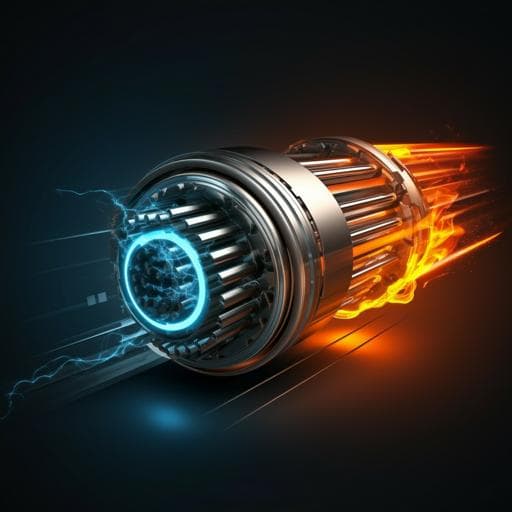
Engineering and Technology
Extreme fast charging of commercial Li-ion batteries via combined thermal switching and self-heating approaches
Y. Zeng, B. Zhang, et al.
This groundbreaking research conducted by Yuqiang Zeng and colleagues at Lawrence Berkeley National Laboratory unveils a novel approach to enhance extreme fast charging (XFC) in lithium-ion batteries. By actively managing self-generated heat, the study demonstrates a transformative method to achieve <15 min charging and 1 h discharging, meeting stringent US Department of Energy targets—all without structural modifications to the batteries.
~3 min • Beginner • English
Introduction
The study addresses the challenge that electric vehicles take >30 minutes to charge to 80% state of charge (SOC), far longer than gasoline refueling. The US Department of Energy (DOE) defines extreme fast charging (XFC) targets: <15 min to 80% SOC, >180 Wh/kg discharge specific energy, and <20% capacity loss after 500 XFC cycles. High-energy-density Li-ion batteries (LIBs) with graphite anodes suffer from lithium plating during 6C charging needed for XFC, leading to rapid degradation. Existing approaches include new electrolytes, electrode materials, optimized charge protocols, and heating strategies. System-level coolant modulation often cannot raise cell temperature sufficiently due to pack thermal mass and low cell-to-pack ratios, while cell-level embedded heaters and permanent insulation raise average operating temperature and conflict with manufacturing and safety. The research hypothesis is that leveraging self-generated heat through active thermal switching (retaining heat during charging to boost kinetics and releasing it during rest/discharge to suppress side reactions) can enable XFC in commercial high-energy-density LIBs without modifying cell materials or structures.
Literature Review
Prior work has targeted XFC via: (1) electrolyte design and additives to improve transport and suppress plating; (2) advanced electrode materials and architectures to increase rate capability; (3) charge protocol optimization, including machine-learning approaches; and (4) thermal strategies to raise temperature before/during fast charge. System-level coolant modulation (adjusting heat transfer coefficient h and coolant temperature) is used in commercial EVs but is limited by pack thermal mass and low cell-to-pack ratios, resulting in insufficient temperature rise and persistent risk of lithium plating. Cell-level strategies using embedded heaters and continuous insulation can raise temperature more effectively, enabling higher C-rates but increase average operating temperature during rest/discharge, accelerating side reactions and posing manufacturing and safety challenges. The gap identified is a need for nonintrusive thermal control that provides low h during charging and high h during rest/discharge, achieving high switching ratios without modifying cells.
Methodology
Modeling: An electrochemical-thermal (ECT) framework coupled a Newman pseudo-2D electrochemical model with a 3D transient heat transfer model (COMSOL Multiphysics 5.6). The model evaluated the required heat transfer coefficients (h) to maintain target temperatures (>45 °C) and avoid negative electrode potentials below 0 V vs. Li/Li+ during 6C charging. A validated pack-level model accounted for low cell-to-pack ratios and heat leakage. Three-electrode pouch cells (32 mAh C||LCO) with a lithium reference were used to validate predicted negative electrode potentials.
Thermal protocols: Four thermal protocols were compared: (1) Cooling: coolant always ON (high h); (2) Coolant modulation (CM): coolant OFF during charging and ON during rest/discharge; (3) Insulation: cell always thermally insulated (low h); (4) Switch + CM (thermally modulated charge protocol, TMCP): active thermal switching (ATS) providing low h (switch OFF, coolant OFF) during XFC and high h (switch ON, coolant ON) during rest/discharge with a target switching ratio h_ON/h_OFF ≈ 10.
Experimental cells and cycling: Commercial high-energy-density 5-Ah graphite||LCO pouch cells (PL-7250115-2C) were tested. Charging used 6C CCCV to 80% SOC (Vcut = 4.2 V), followed by 10 min rest; discharge at 1C to 3.0 V; rest 15–30 min (longer for insulated case) to thermal equilibrium per cycle. Capacity was calibrated every 50 cycles with C/3. Tests were at ambient temperatures (T_a) of 25 °C, 40 °C, and -20 to -25 °C (as specified). Temperature evolution was recorded; coulombic efficiency (CE) and capacity retention were tracked. For low-temperature and nonzero initial SOC (5–15%) conditions, additional XFC tests were performed.
Active thermal switching implementations: (a) Linear actuator rig to vary the gap between the cell and heat sink to emulate ATS and quantify effective h (h extracted via fitting temperature profiles with thermal models). (b) A prototype bistable shape memory alloy (SMA, Nitinol) mechanical thermal switch integrated with a heat-sink plate. Two SMA wires toggled ON/OFF states with brief current pulses (≈1.5 A, 5 s), consuming ≈0.01 Wh per switch. The device provided contact pressure via elastic bands and opened a ~0.5 mm air gap when OFF. Mass and volume overheads were characterized.
Diagnostics: Postmortem analysis of aged negative electrodes included optical microscopy, SEM, and X-ray tomography (ALS Beamline 8.3.2). Electrochemical impedance spectroscopy (EIS) was performed after discharge to 3.0 V and rest, using a 50 mA perturbation from 0.05 to 10 kHz, with equivalent circuit fitting to extract resistances including SEI contributions.
System-level considerations: ECT simulations explored pack-level ATS by moving cold plates via SMA actuation, scalability to higher-capacity cells (e.g., 60 Ah), and compatibility with different BTMS architectures (liquid and air cooling).
Key Findings
- ATS enables desired thermal conditions: low h during XFC to retain self-heat and high h after XFC to dissipate heat. Effective switching ratio ≈10 was achieved; extracted h with switch OFF matched insulation, and h with switch ON matched cooling. Coolant modulation alone (coolant OFF) had ~3× higher h than switch OFF, limiting temperature rise.
- Charge time to 80% SOC at 6C decreased from 25 min (cooling, coolant ON) and 18 min (CM, coolant OFF) to <15 min for insulation and Switch+CM protocols.
- Lithium plating mitigation: High temperature during XFC with Switch+CM increased CE relative to cooling and CM cases, indicating reduced plating. Negative electrode potentials remained above 0 V vs. Li/Li+ when adequately insulated during charge per model.
- Cycle life at Ta ≈ 25 °C: 20% capacity loss occurred at 975 cycles for Switch+CM vs 665 cycles for insulation; cooling and CM showed severe plating and poor CE. At Ta ≥ 40 °C, Switch+CM achieved 560 cycles vs 334 for insulation.
- XFC cycle life: Defined as number of cycles meeting <15 min to 80% SOC, Switch+CM achieved >500 cycles at Ta ≥ 25 °C, while cooling and CM achieved 0 XFC cycles due to time limits.
- SMA-based ATS device demonstration: Comparable temperature profiles and C-rate evolution to the actuator-based ATS; battery surface temperatures ≈42.2 °C (charge) and ≈30.4 °C (discharge). XFC cycle life reached 773 cycles, exceeding the DOE target (500) by ~54.6%. Discharge specific energy after XFC remained >180 Wh/kg through life.
- Degradation mechanisms: Cooling protocol led to widespread plated Li coverage on graphite (optical/SEM), while Switch+CM preserved particle features with evidence of SEI growth; tomography quantified greater porosity loss at end-of-life for Switch+CM attributable to longer life and higher operating temperature but with delayed nonlinear fade due to plating mitigation.
- Normalized longevity: The ratio t_6C1C/t_1C1C was 96.2% with TMCP vs 44.3% reported for heater-embedded insulated cells, indicating plating-induced degradation largely suppressed without substantially accelerating side reactions.
- Low-temperature performance: Relative discharge energy at -20 °C improved with thermal switching to 78.8% (C/3) and 85.0% (1C) of the 30 °C baseline, surpassing the USABC 70% target.
- Device overheads: SMA switch mass, volume, and material cost relative to a cell were ≈1.4%, 3.0%, and 0.7–1.9%, respectively; energy to switch ≈0.01 Wh/cycle (~0.05% of ~18.5 Wh cell energy).
Discussion
The results validate that leveraging self-generated heat with active thermal switching can reconcile the conflicting requirements of XFC: high temperature during charge to boost kinetics and avoid Li plating, and rapid cooling thereafter to limit parasitic reactions. Maintaining higher temperature during the brief XFC window reduces overpotentials at the graphite anode and keeps the anode potential above 0 V vs. Li/Li+, thereby mitigating plating, evidenced by higher CE and reduced plated Li in postmortem analysis. Subsequently increasing thermal conductance reduces time-averaged temperature during rest and discharge, suppressing SEI growth and other side reactions, which enhances cycle life. The approach outperforms constant cooling and coolant-only modulation, which cannot sufficiently raise cell temperature due to pack thermal mass, and improves upon always-insulated strategies by avoiding elevated temperatures during discharge/rest. The SMA-based ATS integrates with existing BTMSs, requires negligible energy to actuate, and adds minimal mass/volume, demonstrating practical feasibility. Applicability extends across graphite-based LIB chemistries (e.g., NMC, LFP positive electrodes), initial SOC variations, and a range of ambient temperatures, though extremely low temperatures will require complementary strategies. Pack-level concepts indicate scalability without intrusive cell modifications, maintaining compatibility with liquid and air-cooled systems.
Conclusion
A thermally modulated charging protocol using active thermal switching was developed and demonstrated to enable XFC in commercial high-energy-density graphite||LCO cells without altering cell materials or structure. By providing low thermal conductance during charging and high conductance during rest/discharge, the method leverages self-heating to mitigate lithium plating and then rapidly dissipates heat to limit side reactions. Experiments and modeling showed <15 min charge times to 80% SOC, discharge specific energy >180 Wh/kg after XFC, and XFC cycle life exceeding DOE targets (up to 773 cycles). Postmortem analyses confirmed reduced plating under the Switch+CM protocol. A compact, low-cost SMA-based thermal switch prototype validated practical integration into BTMSs with minimal penalties. Future work should optimize switch design for higher-capacity cells and full packs, integrate control with smart BTMS algorithms for condition-dependent temperature targets, and develop complementary measures to achieve XFC at very low ambient temperatures.
Limitations
- At very low ambient temperatures (e.g., -20 °C), thermal switching alone could not achieve XFC; additional multilevel R&D (materials, protocols, and thermal strategies) is needed.
- Results are demonstrated primarily on commercial 5-Ah graphite||LCO cells, with broader chemistry validation (e.g., C||NMC) referenced in supplementary data; full cross-chemistry generalization requires further testing.
- Always-insulated strategies show improved charge kinetics but increase side reactions during discharge/rest; while the proposed switching mitigates this, higher operation temperatures still contribute to SEI growth over longer lifetimes.
- Pack-level ATS concepts are proposed and simulated; comprehensive validation in complete EV packs under real-world duty cycles remains future work.
Related Publications
Explore these studies to deepen your understanding of the subject.







